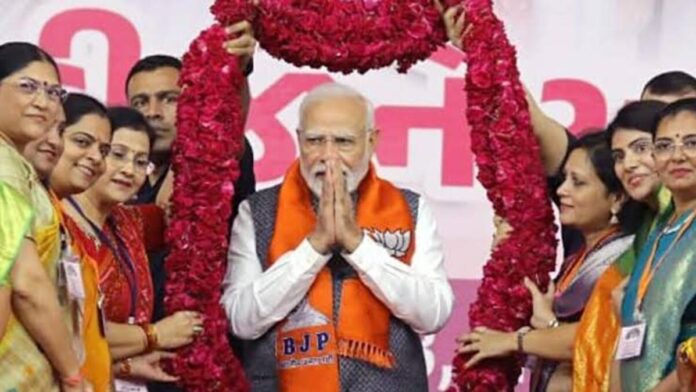In the assembly elections in five states and the general elections in 2024, where the Bharatiya Janata Party’s outreach will be focused on women’s concerns and policies, the new law that reserves 33% seats for women in the Lok Sabha and legislative assemblies will be a major campaign platform.
However, it is unclear if the party will nominate additional female candidates.
The Nari Shakti Vandan Adhiniyam law, which must also be approved by 50% of the states, will not go into force any time soon because it is dependent on the process of redistricting constituencies and conducting the decennial census. While delimitation cannot be conducted till 2026, there is no word on when the census, which has already been delayed, will be carried out.
It will be a tightrope walk for the BJP, which reserves 33% of all party positions for females and has been steadily expanding the number of female candidates in elections, as all eyes will be on whether the party makes a deliberate decision to field more women in the upcoming election season.
Party officials who spoke on the condition of anonymity said there is currently no intention to field 33% women candidates in the poll-bound states of Madhya Pradesh, Rajasthan, Mizoram, Telangana, and Chhattisgarh, but the overall number will be chosen based on a candidate’s chances of winning.
“The party has been encouraging and grooming women leaders. The number of women MPs, legislators and ministers has been on the rise, and the party is committed to reserving 33% seats for women, but it may not happen in the upcoming elections,” a party functionary said.
Citing the example of Madhya Pradesh and Rajasthan, states that have had women chief ministers, the functionary said that social practices prevalent in some communities and regions act as barriers to women from being part of electoral politics.
“It is not uniform across the states, but there are regions or caste groups that tend to prefer men in public life. The process to change the mindset has already begun; the government too focuses on women-centric issues, and we are hopeful that when reservation is implemented, there would be no impediments to women getting their rights,” the functionary said.
In the 230-member Madhya Pradesh assembly, there were 17 fewer women lawmakers in 2018 than there were in 2017. Eight of them belonged to the Congress, and nine to the BJP (one additional candidate was added in a subsequent by-poll). The BJP fielded 24 female candidates in 2018 and 28 female candidates in 2013.
“There was a dip in the number of women given tickets, based on the feedback from constituencies,” the leader quoted above said. In the two lists of candidates released for the upcoming polls, there are 11 women among 79.
Women’s involvement in the 200-member Rajasthan assembly has been steadily rising. With 189 handed tickets in 2018, there were more women running for office than at any time in the previous ten years. In 2013, the BJP gave 25 women voting rights; 19 of them won, and 23 of them did the same in 2018.
“The state has been led by a woman CM (Vasundhara Raje); there have been ministers and MLAs too. Women from the royal families, or from political families taking the lead is encouraging others; but for the change to be substantial, we need more women at the grassroots, at the panchayat and local bodies,” said a second leader.
In the arid state, more women than males vote. Additionally, they voted more frequently in 2018, with a voter percentage of 74.66%, higher than the 73.80% participation of men.
The party also plans to increase the number of female candidates in Chhattisgarh and Telangana. Five of the party’s first 21 candidates on the ballot in Chhattisgarh are female. The 90-member legislature had 14 and 11 female candidates in 2013 and 2018, respectively, but only six and one were elected, respectively.
“There was an overall apathy towards the BJP from a large section of tribal and women voters in the state. That was a reason why both women and male candidates fared badly,” said the first functionary.
The party will also need to concentrate on running more candidates in Mizoram and Telangana, where the party ran six women candidates on party tickets in 2018 and three in 2013, respectively. In Telangana, the party ran 14 women candidates in 2018 and five in 2013.
According to a third party official, Prime Minister Narendra Modi has directed officials to make sure that women are adequately represented among the candidates. He explained that he always inquires about the proportion of female candidates on the list when the central election committee meets.
Ranjana Kumari, director of the think tank Centre for Social Research, suggested that because all political parties have endorsed women’s reservation, they might consider fielding more women instead of waiting for the delimitation and census, which are necessary for implementation.
“We did not need the law to reserve seats for women. It was done because parties made excuses not to give seats to women,” she said. “Now that they have all agreed in principle to reserve 33% seats for women, why wait till 2029 (for the implementation)?”
The absence of a provision for reserving seats for other backward class women from the law should not prevent parties from giving them more tickets, Kumari said. “If they want to give seats, they can choose women from the OBC communities to show their commitment to the cause.”




